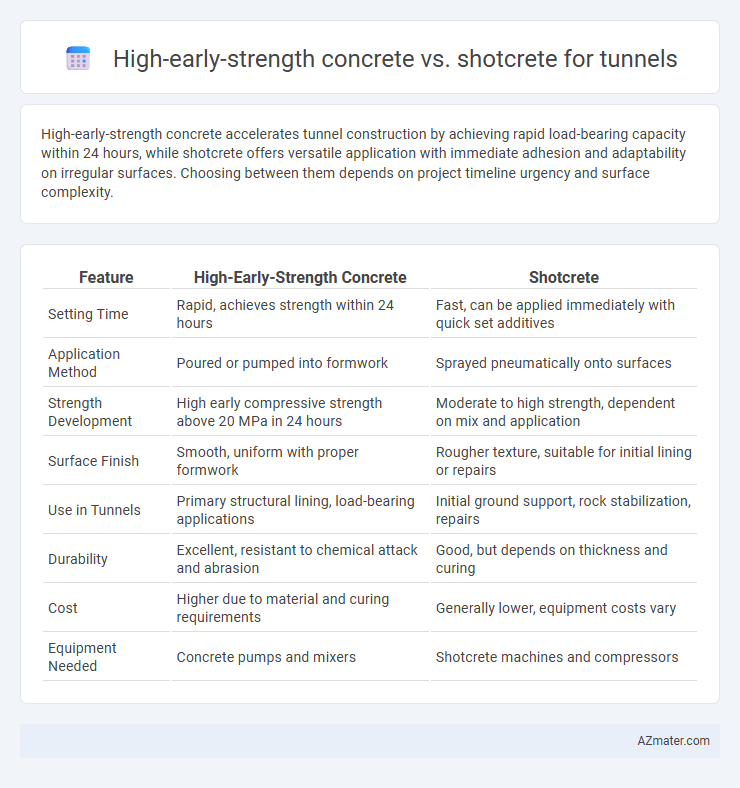High-early-strength concrete accelerates tunnel construction by achieving rapid load-bearing capacity within 24 hours, while shotcrete offers versatile application with immediate adhesion and adaptability on irregular surfaces. Choosing between them depends on project timeline urgency and surface complexity.
Table of Comparison
| Feature | High-Early-Strength Concrete | Shotcrete |
|---|---|---|
| Setting Time | Rapid, achieves strength within 24 hours | Fast, can be applied immediately with quick set additives |
| Application Method | Poured or pumped into formwork | Sprayed pneumatically onto surfaces |
| Strength Development | High early compressive strength above 20 MPa in 24 hours | Moderate to high strength, dependent on mix and application |
| Surface Finish | Smooth, uniform with proper formwork | Rougher texture, suitable for initial lining or repairs |
| Use in Tunnels | Primary structural lining, load-bearing applications | Initial ground support, rock stabilization, repairs |
| Durability | Excellent, resistant to chemical attack and abrasion | Good, but depends on thickness and curing |
| Cost | Higher due to material and curing requirements | Generally lower, equipment costs vary |
| Equipment Needed | Concrete pumps and mixers | Shotcrete machines and compressors |
Introduction: Importance of Concrete Selection in Tunnel Construction
Selecting the appropriate concrete type is crucial in tunnel construction to ensure structural integrity, durability, and safety under challenging geological conditions. High-early-strength concrete offers rapid strength gain essential for fast track construction schedules, while shotcrete provides efficient application on irregular tunnel surfaces and enhanced adhesion to rock formations. Evaluating factors such as curing time, load-bearing capacity, and site-specific conditions guides the choice between these concrete technologies to optimize tunnel performance.
What is High-Early-Strength Concrete?
High-early-strength concrete is a specialized concrete mix designed to achieve significantly higher compressive strength within the first 24 hours compared to conventional concrete, making it ideal for rapid construction applications such as tunnel linings. Its accelerated curing process results from the use of high cement content, chemical accelerators, and optimized aggregate gradation, allowing early load application and quicker formwork removal. This concrete variant enhances construction efficiency and reduces project timelines in tunnel engineering by providing reliable structural support shortly after placement, unlike traditional shotcrete which relies on pneumatic application and may require longer curing periods.
Understanding Shotcrete: Definition and Applications
Shotcrete is a type of concrete conveyed through a hose and pneumatically projected at high velocity onto surfaces, commonly used in tunnel construction for immediate support and stabilization. Its applications include ground improvement, slope stabilization, and structural repairs, offering rapid setting times compared to traditional cast-in-place concrete. High-early-strength concrete differs by providing elevated compressive strength within hours, but shotcrete's method allows for versatile application in complex tunnel geometries and accelerated construction schedules.
Key Material Properties: High-Early-Strength Concrete vs Shotcrete
High-early-strength concrete offers superior compressive strength within 24 hours, reaching 20-30 MPa rapidly, which accelerates tunnel construction schedules. Shotcrete provides excellent adhesion and flexibility, allowing for immediate application on uneven tunnel surfaces with strengths typically ranging from 15-25 MPa depending on mix design and spraying technique. Both materials exhibit good durability and freeze-thaw resistance, but high-early-strength concrete's faster curing enhances early load-bearing capacity, while shotcrete's versatility supports complex geometries in tunnel lining.
Construction Techniques and Methods
High-early-strength concrete achieves rapid curing through specially formulated cement and admixtures, enabling quick formwork removal and early load application, which accelerates tunnel construction schedules. Shotcrete employs pneumatic spraying of concrete onto tunnel surfaces, providing immediate support and conforming to complex geometries without formwork, ideal for irregular tunnel walls and rapid stabilization. Both methods optimize construction efficiency, with high-early-strength concrete favored for precast segments and structural elements, while shotcrete excels in ground support and lining applications.
Performance in Tunnel Environments
High-early-strength concrete achieves rapid strength gain, enabling accelerated construction schedules and early load application in tunnel environments. Shotcrete offers superior adaptability to irregular tunnel surfaces and enhanced adhesion, improving structural integrity in complex geometries. Both materials exhibit excellent durability and resistance to tunnel-specific stresses such as water ingress and ground movement, but shotcrete's spray application reduces labor and time in confined spaces.
Durability and Longevity Comparisons
High-early-strength concrete offers accelerated curing times that provide early load-bearing capacity and enhanced resistance to chemical attacks, contributing to long-term durability in tunnel structures. Shotcrete, applied pneumatically, ensures superior adhesion and compaction in irregular tunnel geometries, improving crack resistance and reducing permeability, which extends service life. Both materials enhance tunnel longevity, but high-early-strength concrete is preferred for structural elements requiring rapid strength gain, while shotcrete excels in repair and lining applications due to its adaptability and durability.
Cost and Time Efficiency Analysis
High-early-strength concrete enables rapid load-bearing capacity, significantly reducing formwork removal time and overall construction schedule in tunnel projects, resulting in cost savings on labor and equipment. Shotcrete offers flexible application with minimal formwork, accelerating construction in complex geometries and minimizing material waste, thus lowering expenses related to logistics and handling. Time efficiency favors high-early-strength concrete for standardized tunnel sections, while shotcrete excels in irregular or hard-to-reach areas, making a hybrid approach cost-effective depending on project specifics.
Safety Considerations for Tunnel Construction
High-early-strength concrete offers rapid load-bearing capacity, reducing support time and enhancing overall tunnel stability during construction, crucial for minimizing collapse risks. Shotcrete provides flexible application on irregular surfaces, improving immediate structural support and worker safety in confined tunnel environments. Both materials demand careful curing and monitoring to prevent early-age cracking, ensuring long-term tunnel integrity and safe passage.
Final Recommendation: Choosing the Optimal Concrete Solution
High-early-strength concrete offers rapid load-bearing capacity crucial for accelerated tunnel construction schedules, while shotcrete excels in adaptability and immediate application on irregular surfaces. Selection depends on project-specific factors such as excavation speed, environmental conditions, and structural requirements. For optimal performance, prioritize high-early-strength concrete in projects demanding swift structural support and shotcrete when flexibility and quick adhesion to complex geometries are paramount.

Infographic: High-early-strength concrete vs Shotcrete for Tunnel
 azmater.com
azmater.com